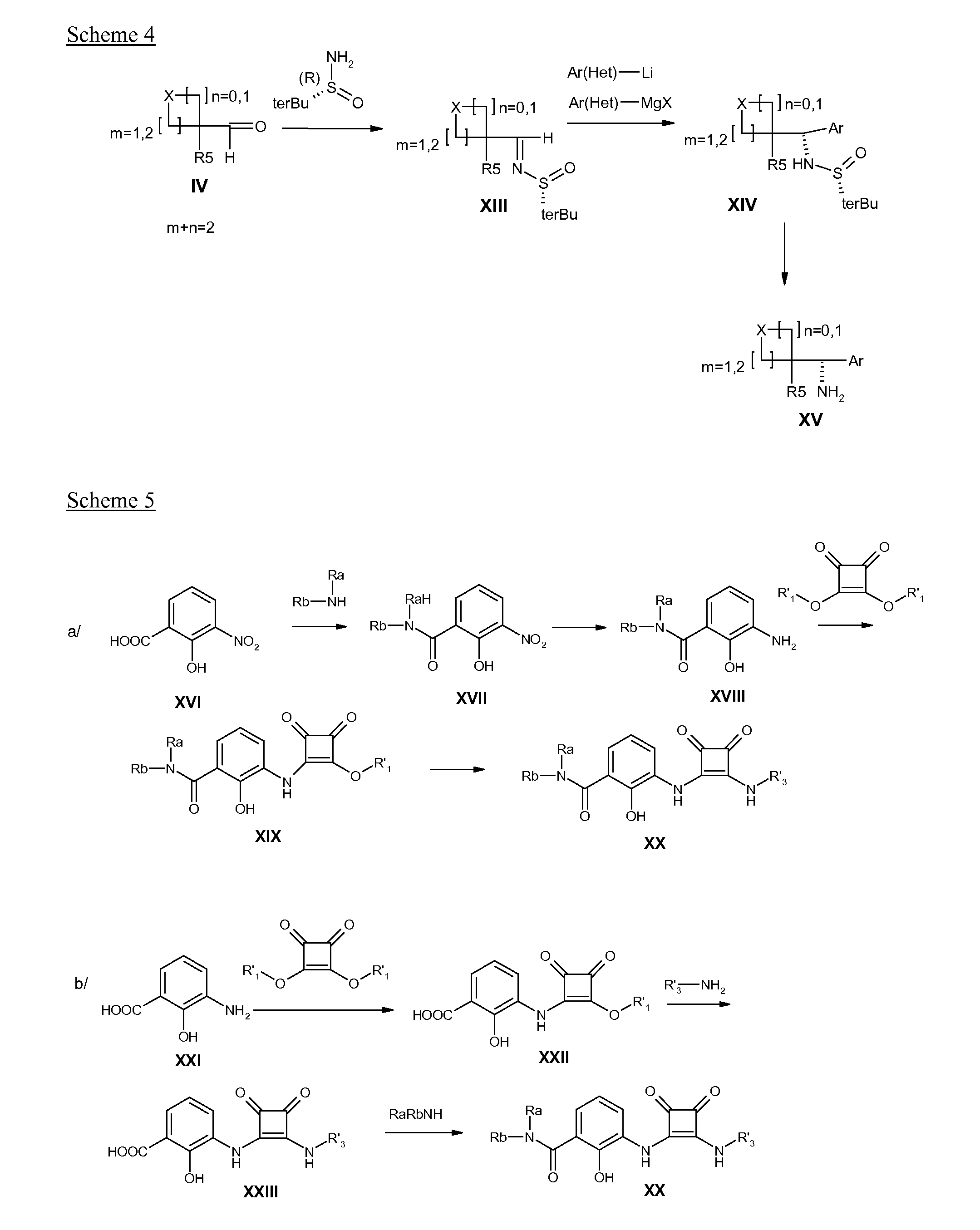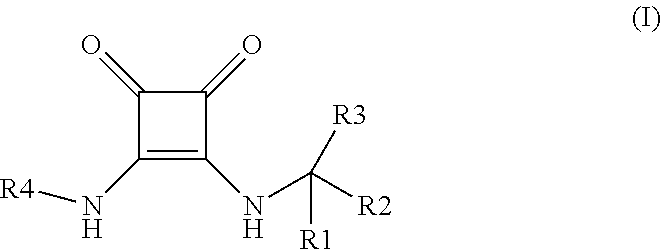Disubstituted 3,4-diamino-3-cyclobutene-1,2-dione compounds for use in the treatment of chemokine-mediated pathologies
a technology of chemokine-mediated pathologies and disubstituted compounds, which is applied in the field of disubstituted 3, 4diamino3cyclobutene1, 2dione compounds, can solve the problems of insufficient clinical studies, unsatisfactory needs, and inability to obtain effective new therapies for treating chemokine-mediated diseases using chemokine receptor antagonists
- Summary
- Abstract
- Description
- Claims
- Application Information
AI Technical Summary
Benefits of technology
Problems solved by technology
Method used
Image
Examples
example 1
Preparation of 2-hydroxy-N,N-dimethyl-3-(2-{[(5-methylfuran-2-yl)-(3-methyloxetan-3-yl)methyl]amino}-3,4-dioxocyclobut-1-enylamino)benzamide
[0110]
Step 1
(5-Methylfuran-2-yl)(3-methyloxetan-3-yl)methanol
[0111]12.0 ml (30 mmol, 1.7 eq) of a 2.5 M solution of n-butyllithium in hexane were added dropwise to a solution of 2.46 g (30 mmol, 1.7 eq) of 2-methylfuran in 50 ml of tetrahydrofuran cooled to −70° C. The reaction medium was stirred and allowed to return to ambient temperature for 3 hours. The reaction medium was cooled to −70° C. and then 2.17 g (18 mmol, 1 eq) of 3-methyloxetane-3-carbaldehyde at 83% were added. The reaction medium was stirred at ambient temperature for 3 hours. The reaction medium was treated with a saturated ammonium chloride solution and extracted with ethyl acetate. The organic phases were combined, washed with a saturated sodium chloride solution and evaporated. 3.02 g of (5-methylfuran-2-yl)-(3-methyloxetan-3-yl)methanol were obtained in the form of an oran...
example 2
3-(2-{[(3-fluoromethyloxetan-3-yl)-(5-methyl-furan-2-yl)methyl}amino]-3,4-dioxocyclobut-1-enylamino)-2-hydroxy-N,N-dimethylbenzamide
[0120]
Step 1
(3-Fluoromethyloxetan-3-yl)methanol
[0121]A mixture of 21.5 g (0.119 mol, 1 eq) of 3-bromomethyl-3-hydroxymethyloxetane and 27.7 g (0.476 mol, 4 eq) of potassium fluoride in 60 ml of diethylene glycol was heated at 150° C. for 3 hours. The reaction medium was diluted with 120 ml of water and extracted with diethyl ether (18×30 ml) and then with ethyl acetate (8×50 ml). The organic phases were combined, dried over magnesium sulfate and evaporated. The residue was chromatographed on silica gel (column SuperFlash SF40-240 g) eluted with 30 / 70 heptane / ethyl acetate (elimination of the diethylene glycol). 10.55 g of (3-fluoromethyloxetan-3-yl)methanol were recovered in the form of a colorless oil. Yield=74%. TLC SiO2 / Heptane:EtOAc (20 / 80), developing with KMnO4.
Step 2
3-Fluoromethyloxetane-3-carbaldehyde
[0122]A solution of 5.3 g (44 mmol, 1 eq) of ...
example 3
Preparation of 3-(2-{[(3-ethyloxetan-3-yl)-(5-methylfuran-2-yl)methyl]amino}-3,4-dioxocyclobut-1-enylamino)-2-hydroxy-N,N-dimethylbenzamide
[0129]
Step 1
3-Ethyloxetane-3-carbaldehyde
[0130]A solution of (3-ethyloxetan-3-yl)methanol (5.0 g, 43.0 mmol) in 60 ml of dichloromethane was added dropwise to a mixture of pyridinium chlorochromate (14.85 g, 68.9 mmol) and celite (4.30 g) in 200 ml of dichloromethane. The reaction medium was stirred at ambient temperature for 5 hours. The reaction medium was filtered on 70 g of silica and eluted with dichloromethane. The organic phases were combined and concentrated. 4.0 g of the expected product were obtained in the form of a pale green oil. Yield=82.3%.
Step 2
[0131]In a manner analogous to EXAMPLE 1 (step 1), (3-ethyloxetan-3-yl)-(5-methylfuran-2-yl)methanol was prepared. Yield=82%.
Step 3
[0132]In a manner analogous to EXAMPLE 1 (step 2), 2-[azido(3-ethyloxetan-3-yl)methyl]-5-methylfuran was prepared. Yield=53%.
Step 4
[0133]In a manner analogous t...
PUM
| Property | Measurement | Unit |
|---|---|---|
| Composition | aaaaa | aaaaa |
Abstract
Description
Claims
Application Information
 Login to View More
Login to View More - R&D
- Intellectual Property
- Life Sciences
- Materials
- Tech Scout
- Unparalleled Data Quality
- Higher Quality Content
- 60% Fewer Hallucinations
Browse by: Latest US Patents, China's latest patents, Technical Efficacy Thesaurus, Application Domain, Technology Topic, Popular Technical Reports.
© 2025 PatSnap. All rights reserved.Legal|Privacy policy|Modern Slavery Act Transparency Statement|Sitemap|About US| Contact US: help@patsnap.com



